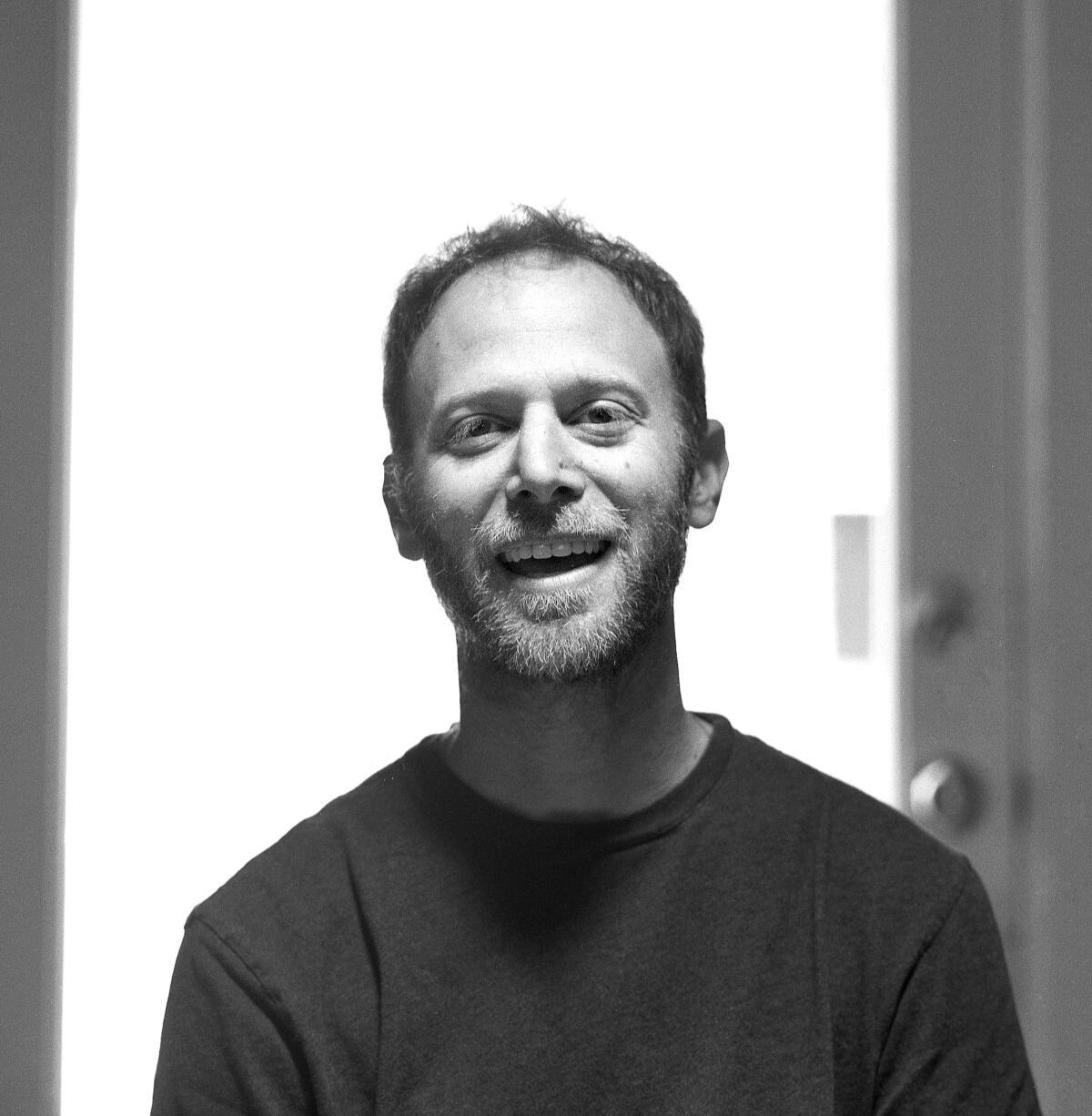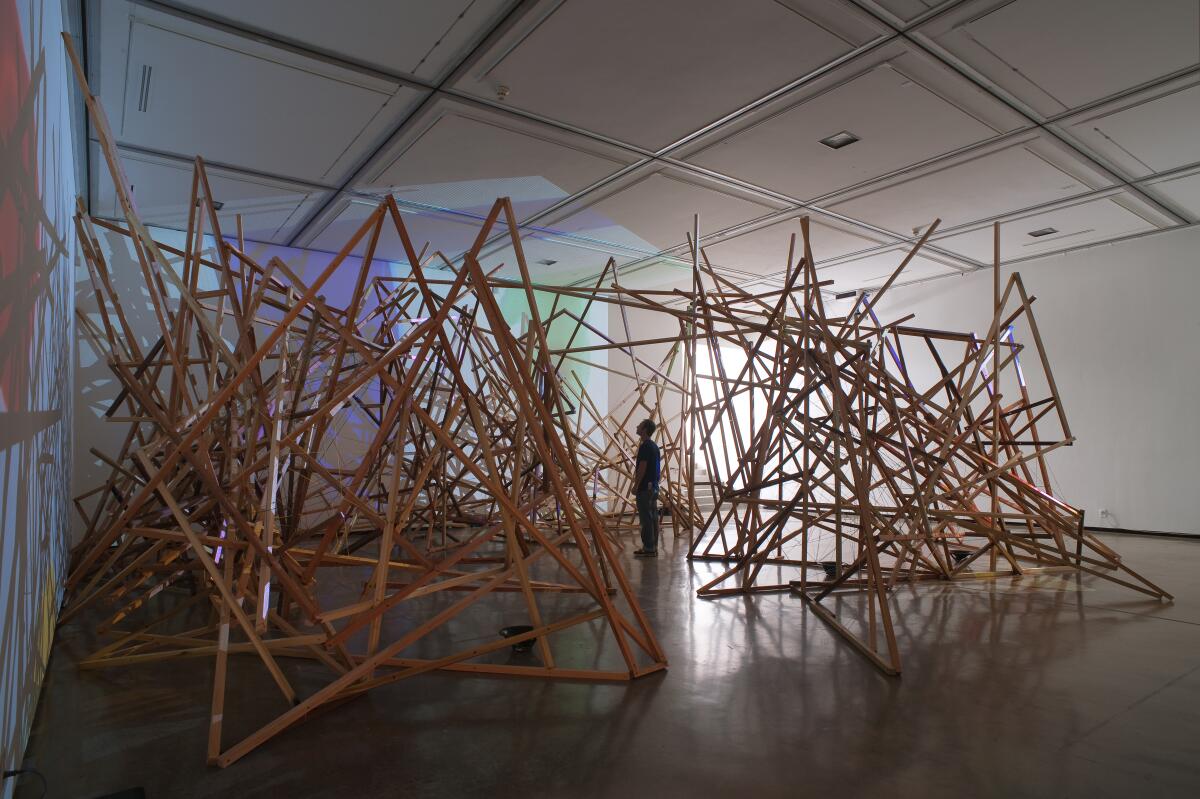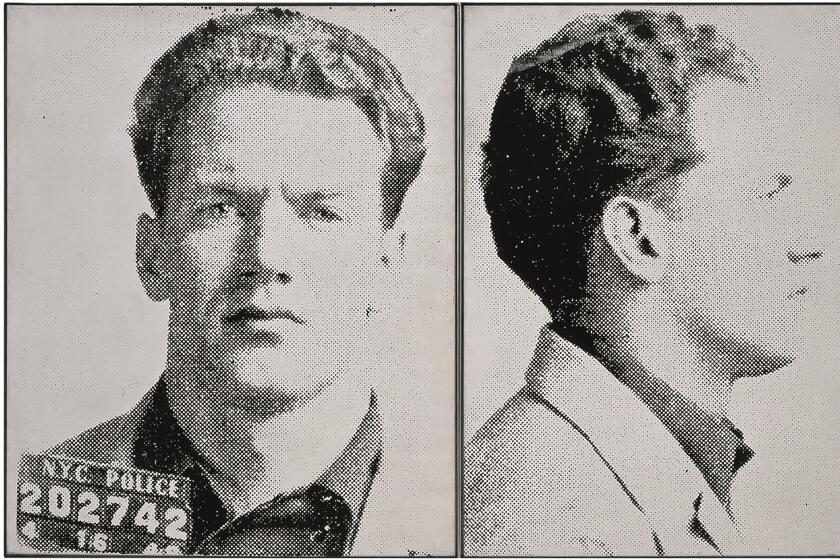Steve Roden, a vivaciously inventive and quintessential ‘artist’s artist,’ dies at 59

- Share via
Steve Roden, a multidisciplinary artist whose abstract work in painting, sculpture, sound, installation and video fused delicate nuance with vivacious invention, died at home in Pasadena on Wednesday. He was 59. Roden had been diagnosed with Alzheimer’s disease in 2017.
Roden’s final solo exhibition at Susanne Vielmetter Los Angeles, the gallery where he showed regularly for nearly 20 years, was mounted in the summer of 2019. During the subsequent pandemic, he continued to work privately in his studio. Earlier examples of his distinctive aesthetic were featured in recent group exhibitions in California and Europe, including “Audiosphere: Sound Experimentation 1980-2020,” a major survey of contemporary sound art at the Museo Nacional Centro de Arte Reina Sofia in Madrid.
Roden’s work is scheduled for inclusion in next year’s “Energy Fields: Vibrations of the Pacific” at Chapman University, part of the Getty Foundation’s upcoming Pacific Standard Time initiative exploring intersections between art and science. He was the subject of a 2010 midcareer retrospective at the Pasadena Armory Center for the Arts, and his work is in the collections of the Museum of Contemporary Art and the National Museum of Contemporary Art in Athens, Greece.
This article was originally on a blog post platform and may be missing photos, graphics or links.
The Vielmetter exhibition cross-referenced elaborate paintings with a pair of projected videos and a sound installation, its sonic form made by blowing into the disassembled wooden reed boxes of a vintage pipe organ. The videos featured the artist manipulating bits of collage into place, although everything is provisional, nothing permanently fixed. Titled “detritus” (debris) and “orrery” (a mechanical model of the solar system), all written in lower-case letters, the modest visual narratives have no beginning and no end. The shifting forms, however, were reflected in paintings constructed from crystalline shapes assembled from brightly colored, improvisational marks, almost in the manner of song.
Roden once described painting as “the sun” around which other art hovers, but those other forms were integral to its making.
Born April 27, 1964, Roden expanded his musical interests at Beverly Hills High School, where he and two friends formed a punk rock band, which they called Seditionaries. The group shared its name with the London punk clothing shop run by Malcolm McLaren and Vivienne Westwood. The band, despite its members’ youth, played gigs with the Circle Jerks and the English group the Damned, and appeared at the Troubadour in West Hollywood. Roden later created the ethereal soundtrack heard at the beginning of the popular Modern Art Notes Podcast.

Roden earned a 1986 BFA at Otis Art Institute, now Otis College of Art and Design, when it was located at MacArthur Park near downtown L.A. and affiliated with New York’s Parsons School of Design. He received a master’s degree from Pasadena’s Art Center College of Design in 1989. His instructors at the two schools included artists Emerson Woelffer, Roy Dowell, Mike Kelley, Stephen Prina and Gary Panter, many of whom also embraced multidisciplinary forms and cross-cultural influences in their work. With cartoonist Dan Goodsell, Roden would later publish “Krazy Kids’ Food!,” a Taschen book of vintage commercial graphic designs.
While still a student, Roden met artist and designer Sari Takahashi, and the couple married in 1993. Five years later they acquired an eccentric 1946 house in Pasadena, known as the “Airform Bubble House.” Designed by celebrated residential architect Wallace Neff, the landmark is shaped like a large, concrete igloo. Neff envisioned a quick, inexpensive form of mass-produced housing made by inflating a large, industrial-strength balloon, pneumatically spraying it with Gunite (the material often used to coat the surface of swimming pools), then deflating the balloon and pulling it out through the doorway. The process took just 48 hours, using no wood or nails.
Several bubble houses were built across the country, but the Rodens’ home is the only one that remains. Although curved walls limited functionality, a roughly thousand-square-foot house formed from air was ideal for an artist of Roden’s poetic sensibilities. Pointing to the curved, pock-marked ceiling, he once explained to a KCRW reporter that the acoustics were surprising.
“It was concrete resting on a balloon being supported by air, so in the areas where there’s a little bit of disruption of the surface, you get these pockets,” he said. “So once in a while, depending on where you are standing, you have a parabolic where you have sound coming directly down into your ear but no one else can hear it.”
Commentary: Donald Trump’s campy mug shot gives Andy Warhol’s infamous mural some competition
Andy Warhol’s disastrous 1964 mug shot mural was most certainly political, like Donald Trump’s recently released booking photo.
The Getty Research Institute and Los Angeles Contemporary Exhibitions, in partnership with MOCA, engaged Roden in 2008 to reimagine Allan Kaprow’s seminal performance series, “18 Happenings in 6 Parts,” first presented a half-century earlier at New York’s Reuben Gallery. In a remembrance on the Legacy website, curator Meg Linton quoted the GRI’s Glenn R. Phillips, who noted, “At the heart of [Roden’s] work is an incredible sense of play that can delight in taking an idea from the mind to the page, to the canvas, into sound, into space, and then back to the mind again.”
Roden was a quintessential “artist’s artist,” widely admired by his peers. In the Pasadena Armory Center mid-career survey, as well as a related show of new work at the Pomona College Museum of Art (now the Benton Museum), Roden’s art embraced a spiritual tradition familiar from such disparate 20th century predecessors as Arthur Dove, Paul Klee and Alfred Jensen. His paintings and sculptures, notoriously difficult to describe, merge logical systems and formal structures with highly personal and improvisational rhythms. The art becomes a field of dynamic engagement.
In addition to his wife, the artist is survived by his mother, Susan Roden. A memorial gathering is being planned.

More to Read
The biggest entertainment stories
Get our big stories about Hollywood, film, television, music, arts, culture and more right in your inbox as soon as they publish.
You may occasionally receive promotional content from the Los Angeles Times.












